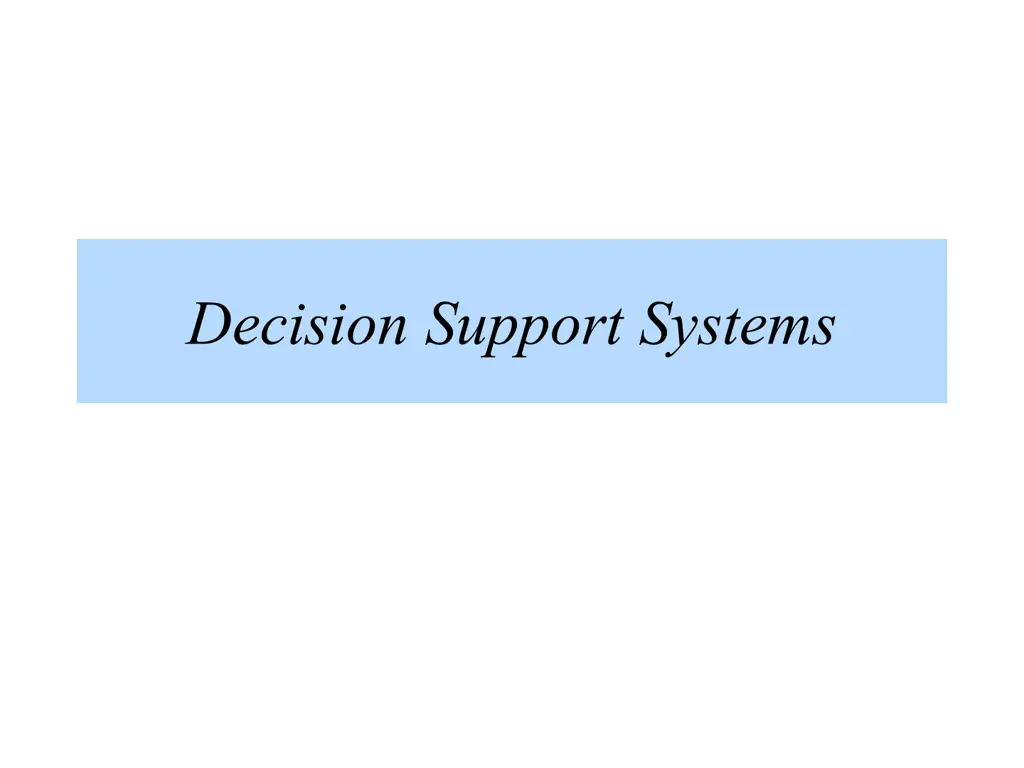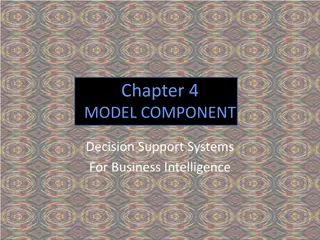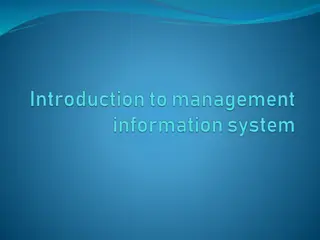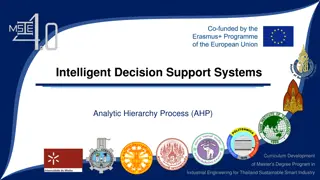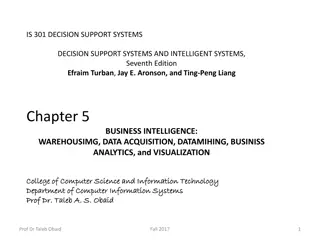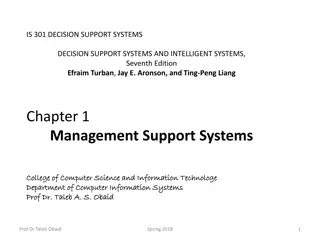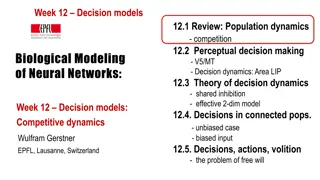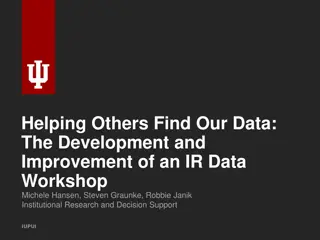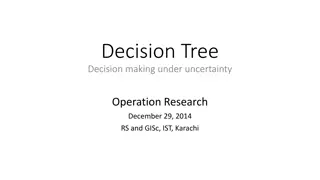Decision Support Systems
Decision Support Systems (DSS) offer potential to assist in solving both semi-structured and unstructured problems. They provide capabilities to handle large amounts of data, perform complex analysis, and support different decision-making approaches.
- Decision Support Systems
- Problem Solving
- Decision Making
- Analysis
- Data Handling
- Optimization
- Simulation
- Goal Seeking
Download Presentation

Please find below an Image/Link to download the presentation.
The content on the website is provided AS IS for your information and personal use only. It may not be sold, licensed, or shared on other websites without obtaining consent from the author. Download presentation by click this link. If you encounter any issues during the download, it is possible that the publisher has removed the file from their server.
E N D
Presentation Transcript
Decision Support Systems Decision support systems (DSS) Offer potential to assist in solving both semi- structured and unstructured problems
Decision Making as a Component of Problem Solving Intelligence Decision making Design Problem solving Choice Implementation Monitoring
Problem Solving Factors Multiple decision objectives Increased alternatives Increased competition The need for creativity Social and political actions International aspects Technology Time compression
Characteristics of a DSS (1) Handles large amounts of data from different sources Provides report and presentation flexibility Offers both textual and graphical orientation
Characteristics of a DSS (2) Supports drill down analysis Performs complex, sophisticated analysis and comparisons using advanced software packages Supports optimization, satisficing, and heuristic approaches
Characteristics of a DSS (3) Performs different types of analyses What-if analysis Makes hypothetical changes to problem and observes impact on the results Simulation Duplicates features of a real system Goal-seeking analysis Determines problem data required for a given result
Goal Seeking Example You know the desired result You want to know the required input(s) Example: Microsoft Excel s Goal Seek and Solver functions
Excel demo
Capabilities of a DSS (1) Supports Problem solving phases Different decision frequencies Merge with another company? How many widgets should I order? low high Frequency
Capabilities of a DSS (2) Highly structured problems Straightforward problems, requiring known facts and relationships. Semi-structured or unstructured problems Complex problems wherein relationships among data are not always clear, the data may be in a variety of formats, and are often difficult to manipulate or obtain
Decision Making Levels Strategic Strategic-level managers involved with long-term decisions Tactical Operational-level managers involved with daily decisions Operational High Low Decision Frequency
Integration of TPS, MIS, and DSS In many organizations they are integrated through a common database Separation of DSS transactions in the database from TPS and MIS transactions may be important for performance reasons
Web-Based Decision Support Systems Web-based decision support systems Decision support system software provides business intelligence through web browser clients that access databases either through the Internet or a corporate intranet
Components of a DSS Model management software (MMS) Coordinates the use of models in the DSS Model base Provides decision makers with access to a variety of models Dialogue manager Allows decision makers to easily access and manipulate the DSS
Database Model base DBMS MMS Access to the internet, networks, and other computer systems External database access External databases Dialogue manager
Model Base Model Base Provides decision makers with access to a variety of models and assists them in decision making Models Financial models Statistical analysis models Graphical models Project management models
Advantages and Disadvantages of Modeling Advantages Less expensive than custom approaches or real systems. Faster to construct than real systems Less risky than real systems Provides learning experience (trial and error) Future projections are possible Can test assumptions Disadvantages Assumptions about reality may be incorrect Accuracy of predications often unreliable Requires abstract thinking
Group Decision Support System Group Decision Support System (GDSS) Contains most of the elements of DSS plus software to provide effective support in group decision-making settings
Databases Model base GDSS processor GDSS software Access to the internet and corporate intranet, networks, and other computer system Dialogue manager External database access External databases Users
Characteristics of a GDSS (1) Special design Ease of use Flexibility Decision-making support Delphi approach (decision makers are geographically dispersed) Brainstorming Group consensus Nominal group technique
Characteristics of a GDSS (2) Anonymous input Reduction of negative group behaviour Parallel communication Automated record keeping Cost, control, complexity factors
Components of a GDSS and GDSS Software Database Model base Dialogue manager Communication capability Special software (also called GroupWare) E.g., Lotus Notes people located around the world work on the same project, documents, and files, efficiently and at the same time
Decision Room Decision Room For decision makers located in the same geographic area or building Use of computing devices, special software, networking capabilities, display equipment, and a session leader Collect, coordinate, and feed back organized information to help a group make a decision Combines face-to-face verbal interaction with technology-aided formalization
Wide Area Decision Network Characteristics Location of group members is distant Decision frequency is high Virtual workgroups Groups of workers located around the world working on common problems via a GDSS
Executive Support System Characteristics A specialized DSS that includes all the hardware, software, data, procedures, and people used to assist senior-level executives within the organization Board of directors President Function area vice presidents Function area managers
Characteristics of ESSs Tailored to individual executives Easy to use Drill down capabilities Support the need for external data Help with situations with high degree of uncertainty Futures orientation (predictions, forecasting) Linked with value-added business processes
Capabilities of an ESS Support for defining overall vision strategic planning strategic organizing and staffing strategic control crisis management
